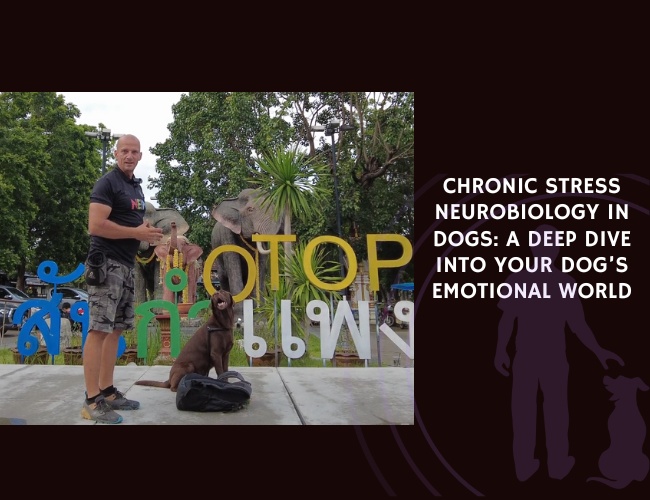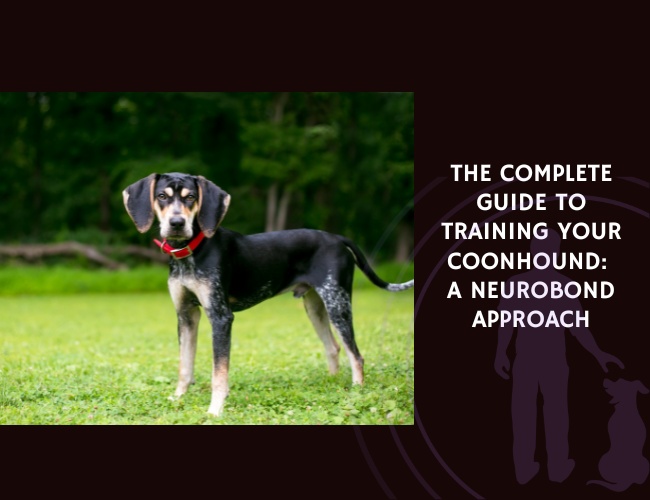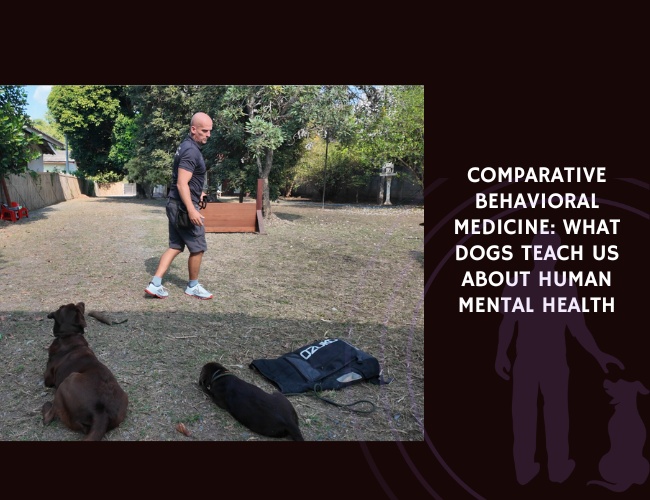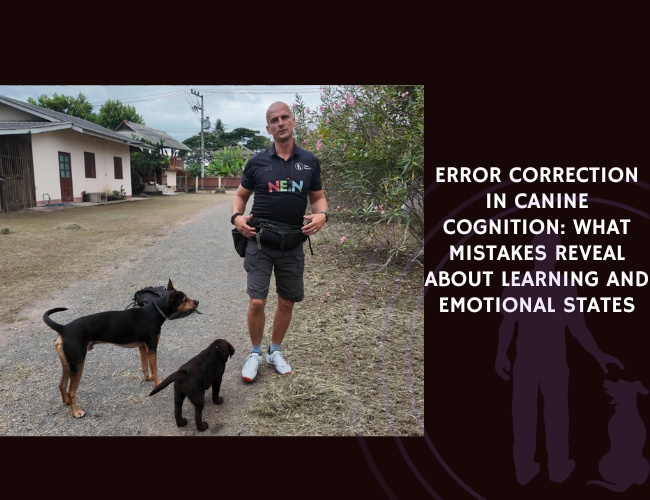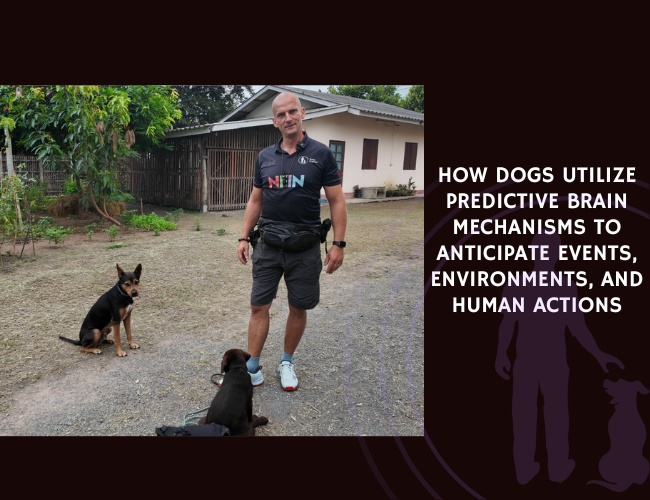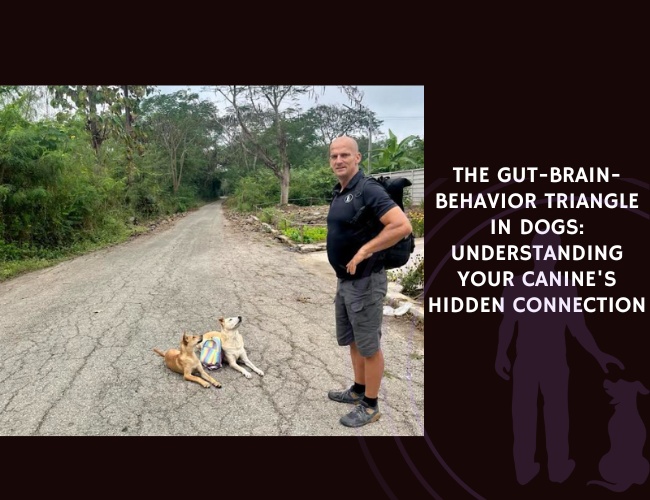Introduction: When Stress Becomes More Than Just a Bad Day
Have you ever noticed your furry friend seeming “off” for weeks at a time? Perhaps they’re less playful, more reactive, or showing behaviors that worry you. You’re witnessing something profound happening in their brain and body – a complex orchestration of stress responses that, when prolonged, can fundamentally change who your dog is. Let us guide you through the fascinating and sometimes concerning world of chronic stress in dogs, where cutting-edge neuroscience meets the everyday reality of caring for our beloved companions.
Understanding chronic stress isn’t just about recognizing when your dog is having a tough time. It’s about appreciating the intricate dance between their brain, hormones, and behavior – a dance that evolved to keep them safe but can sometimes work against them in our modern world. Did you know that your dog’s stress response system is remarkably similar to yours? This shared biology means that what we’ve learned from decades of human stress research can help us better understand and support our canine companions. 🧡
The Stress Symphony: Understanding Your Dog’s HPA Axis
What Happens When Your Dog Feels Stressed
When your dog perceives a threat – whether it’s a thunderstorm, a visit to the vet, or even subtle changes in your household routine – their body launches an incredible cascade of responses. At the heart of this system is something called the HPA axis, which stands for hypothalamic-pituitary-adrenal axis. Think of it as your dog’s internal alarm system, beautifully designed to help them survive challenges.
The moment stress strikes, your dog’s hypothalamus (a tiny region deep in their brain) sends out an urgent message. This message travels to the pituitary gland, which then signals the adrenal glands sitting atop the kidneys. The result? A surge of cortisol – often called the “stress hormone” – flooding through your dog’s bloodstream. In the short term, this is brilliant design. Cortisol helps your dog mobilize energy, sharpen their focus, and prepare for action. It’s why your normally calm companion can suddenly leap over a fence when frightened or why they seem hyperalert during a storm.
But here’s where things get complicated. This system was designed for brief emergencies – think escaping from a predator or competing for resources. In our modern world, many dogs experience persistent, low-level stressors that keep this system activated far longer than nature intended. When the alarm never fully turns off, that’s when we see the emergence of chronic stress and its troubling consequences.
The Hidden Cost of Constant Vigilance
You might wonder, “If cortisol helps my dog respond to challenges, why is too much a problem?” Imagine if your smoke alarm went off every few minutes, all day long. Eventually, you’d either become exhausted from the constant alertness, or you’d start ignoring it altogether. Your dog’s stress system faces the same dilemma with chronic activation.
Research has revealed something remarkable: Dogs rescued from traumatic situations, such as meat farms in South Korea, show hair cortisol concentrations more than twice as high as typical pet dogs. This isn’t just a number on a lab report – it’s biological evidence of prolonged suffering written into the very structure of their fur. Each strand of hair becomes a timeline of stress, recording months of elevated cortisol like rings in a tree trunk record years of growth.
The paradox of chronic stress is that sometimes, after prolonged activation, the system can swing in the opposite direction. Some chronically stressed dogs actually show lower than normal cortisol levels – their stress response system essentially burning out from overuse. It’s as if their body’s alarm system has become so exhausted it can barely sound anymore, leaving them vulnerable and dysregulated.
Reading the Signs: How Chronic Stress Manifests in Your Dog
Behavioral Changes That Tell a Story
When we talk about chronic stress in dogs, we’re not just discussing abstract concepts – we’re talking about real changes you might notice in your living room, on your daily walks, or during playtime at the park. These behavioral shifts are your dog’s way of communicating that their internal world has become overwhelming. Learning to read these signs isn’t just about identifying problems – it’s about understanding your dog’s emotional language and recognizing when they need extra support.
Anxiety and withdrawal often emerge first, sometimes so gradually you might not notice until you look back and realize your dog has fundamentally changed. Your once-confident dog might start hesitating at doorways, as if each threshold represents a decision too overwhelming to make quickly. They might avoid certain rooms – perhaps the living room where the TV is often loud, or the kitchen where they once got startled by a falling pan. Some dogs become velcro dogs, following you from room to room, even to the bathroom, seeking the reassurance of your presence like a life raft in an ocean of uncertainty.
The withdrawal can be heartbreaking to witness. That dog who used to bound out the door for walks might now need coaxing just to step outside. The enthusiastic greeting ritual when you come home might dwindle to a lifted head and half-hearted tail wag. Some dogs develop what looks remarkably like human depression – sleeping 18-20 hours a day, lying in the same spot for hours, staring at walls, or seeming to look through you rather than at you. They might stop soliciting play, ignore their favorite toys, or show no interest when you grab the leash. This isn’t your dog being “stubborn” or “lazy” – it’s their brain struggling under the weight of chronic stress, depleted of the neurochemicals that create joy and motivation.
Reactivity and aggression represent another face of chronic stress, often the most challenging for families to navigate. That sweet dog who used to greet every visitor with a wagging tail might start barking the moment they hear footsteps outside. The barking isn’t just louder – it has a different quality, more frantic, more desperate. On walks, they might start lunging at other dogs, bikes, or even leaves blowing in the wind. Their body language changes too – hackles raised, body stiff, eyes hard and focused.
What’s particularly distressing is when aggression appears toward familiar people or situations. Your dog might suddenly growl when you reach for their collar, snap when a child runs past, or guard resources they never cared about before. Their threshold for tolerating everyday annoyances drops dramatically. The cat walking by, a door closing too loudly, someone sitting in “their” spot on the couch – any of these might trigger an outsized reaction. Think of it like this: when you’re exhausted and stressed, don’t small irritations feel monumentally frustrating? That sock on the floor becomes infuriating. That repeated notification sound makes you want to throw your phone. Your dog experiences the same emotional amplification, but without the cognitive tools to understand why everything suddenly feels so overwhelming.
Compulsive behaviors can emerge as your dog attempts to self-soothe, creating their own coping mechanisms in the absence of other relief. Excessive licking is often the first sign – starting with normal grooming that gradually extends into hours of methodical licking of paws, legs, or flanks. Some dogs create raw spots called lick granulomas, wounds that won’t heal because the dog can’t stop licking them. The licking becomes ritualistic, almost trance-like, and interrupting it might cause visible distress.
Tail chasing might start as occasional play but evolve into frantic spinning sessions that leave your dog exhausted and disoriented. Shadow chasing can consume hours of your dog’s day, turning them into prisoners of light patterns on the wall. Some dogs develop fixations on reflections, becoming hypervigilant for any glimpse of light on surfaces. Repetitive pacing follows the same routes – around the coffee table, along the fence line, from window to window – wearing literal paths in your carpet or yard. These aren’t just quirky habits or attention-seeking behaviors – they’re signs of a stressed brain seeking relief through repetitive action. These behaviors release small amounts of endorphins and dopamine, providing temporary escape from chronic discomfort, much like how some humans might obsessively check their phones or engage in other repetitive behaviors when anxious.
Physical Manifestations You Might Overlook
Chronic stress doesn’t just affect behavior – it shows up in your dog’s body in ways you might not immediately connect to emotional distress. Understanding these physical signs helps you build a more complete picture of your dog’s stress levels and catch problems earlier.
Digestive disruptions are incredibly common in chronically stressed dogs. You might notice recurring diarrhea or constipation, often alternating unpredictably. Some dogs vomit bile in the early morning, their empty stomachs churning with stress hormones. Others develop inflammatory bowel conditions that seem to flare during particularly stressful periods. Appetite changes are telling too – some stressed dogs become picky eaters, turning away from foods they once loved, while others seem constantly hungry, as if trying to fill an emotional void with food. The gut-brain connection is so strong that veterinary behaviorists often say, “The gut is the second brain,” and chronic stress proves this connection dramatically.
Skin and coat changes offer visible evidence of internal turmoil. That glossy coat might become dull and brittle. Some dogs develop stress-related alopecia, losing hair in patches without any underlying skin disease. Others might show premature graying, especially around the muzzle and eyes – yes, dogs can literally go gray from stress, just like humans. Chronic stress suppresses the immune system, making skin infections, hot spots, and allergic reactions more likely and harder to resolve. You might find yourself at the vet repeatedly for skin issues, never realizing the root cause is emotional rather than purely physical.
Sleep disturbances mirror human stress patterns remarkably closely. Your dog might become restless at night, getting up repeatedly to pace, drink water, or ask to go outside. Some develop a reversed sleep cycle, sleeping all day but remaining alert and anxious at night. Others experience what seems like doggy insomnia – lying awake, eyes open, hypervigilant to every sound. The restorative deep sleep necessary for physical and mental recovery becomes elusive, creating a vicious cycle where poor sleep worsens stress, which further disrupts sleep.
Subtle Communication Changes
The way your stressed dog communicates – both with you and with other dogs – undergoes subtle but significant changes that reveal their internal struggle. These changes in their social language often go unnoticed but provide crucial insights into their emotional state.
Vocalization patterns shift in telling ways. Some dogs become increasingly vocal, whining at seemingly nothing, demand barking for attention, or howling when left alone even briefly. The quality of their vocalizations changes too – barks might become higher-pitched and more rapid, whines might take on a desperate quality, and some dogs develop an almost constant low grumbling or mumbling as if conducting an ongoing conversation with their stress. Conversely, some chronically stressed dogs become eerily quiet, losing their voice in a sense, no longer barking to announce visitors or whining for dinner. This silence isn’t peaceful – it’s resignation.
Body language becomes contradictory or confusing. Your dog might approach you for affection but then stiffen when touched. They might play bow to another dog but then immediately retreat. These mixed signals reflect internal conflict – the desire for normal interaction battling with stress-induced wariness. Watch for subtle stress indicators: excessive yawning when not tired, lip licking when no food is present, sudden scratching when nothing itches, or the “wet dog shake” when completely dry. These are all displacement behaviors – actions that seem out of context but help the dog cope with emotional discomfort.
Social dynamics change both with humans and other animals. A previously social dog might start avoiding dog park interactions, hiding behind your legs or asking to leave shortly after arriving. Multi-dog households might see shifting dynamics – a typically subordinate dog becoming uncharacteristically assertive, or a previously confident dog yielding resources they once guarded. With humans, you might notice your dog becoming selectively social, bonding intensely with one family member while avoiding others, or showing stress around specific types of people (men with beards, children, people in uniforms) they previously ignored.

Age-Related Stress Presentations
How chronic stress manifests can vary dramatically depending on your dog’s life stage, and recognizing these age-specific patterns helps ensure appropriate intervention.
Puppies and adolescents experiencing chronic stress might show developmental delays or regressions. Housetrained puppies might start having accidents again. Social skills learned in puppy class might seem to evaporate. The normal adolescent pushing of boundaries becomes extreme, with the stressed teenage dog seeming unable to retain any training. Some young dogs develop an almost manic energy, unable to settle even when exhausted, their stress manifesting as hyperactivity rather than withdrawal. Others show precocious fearfulness, developing phobias and anxieties typically seen in older dogs who’ve had negative experiences.
Adult dogs often show the classic stress signs we’ve discussed, but the changes might be dismissed as “maturity” or “settling down.” That playful three-year-old who becomes serious and aloof might not be “growing up” – they might be struggling with accumulated stress. The prime of their life, when they should be confident and stable, instead becomes marked by increasing anxiety, reactivity, or compulsive behaviors. Because adult dogs are expected to be trained and settled, their stress symptoms might be labeled as “stubbornness” or “regression” rather than recognized as cries for help.
Senior dogs present unique challenges in identifying chronic stress because symptoms overlap with normal aging. Is that increased vocalization at night stress, cognitive decline, or both? Is the reluctance to go for walks arthritis, anxiety, or a combination? Chronic stress can accelerate cognitive dysfunction syndrome (doggy dementia), making it crucial to address stress in aging dogs. Some seniors develop late-onset separation anxiety, becoming distressed when left alone despite years of being fine. Others might show increased irritability that’s dismissed as “grumpy old dog syndrome” when it’s actually chronic stress compounding the challenges of aging.
The Cognitive Impact You Might Not See
Beyond the obvious behavioral changes, chronic stress subtly erodes your dog’s cognitive abilities in ways that might not be immediately apparent. You might notice your well-trained dog suddenly “forgetting” commands they’ve known for years. This isn’t defiance – it’s their stressed brain struggling to access and process information effectively.
Memory and learning suffer significantly under chronic stress. The hippocampus, crucial for forming new memories and recalling old ones, is particularly vulnerable to prolonged cortisol exposure. Studies in various species, including preliminary research in dogs, show that chronic stress can actually shrink the hippocampus. Imagine trying to save files on a computer with a failing hard drive – that’s what your chronically stressed dog faces when trying to learn or remember.
Decision-making becomes impaired too. Your dog might seem indecisive, taking longer to respond to cues or seeming confused in familiar situations. They might make poor choices, like eating things they shouldn’t or failing to come when called despite knowing better. This isn’t willful disobedience – it’s a brain overwhelmed by stress hormones struggling to evaluate options and make good decisions.
The Brain Under Siege: Neurobiological Changes from Chronic Stress
When Stress Rewires the Brain
Let’s dive deeper into what’s actually happening inside your dog’s brain during chronic stress. This isn’t just about temporary chemical changes – we’re talking about structural alterations that can persist long after the stressor has passed. Understanding these changes helps explain why simply removing a stressor doesn’t immediately “fix” a chronically stressed dog. Think of it like this: if stress is the storm, these brain changes are the flood damage that remains even after the clouds have cleared.
The hippocampus takes the hardest hit, and the damage is both profound and multifaceted. This seahorse-shaped structure deep in your dog’s brain doesn’t just handle memory – it also helps regulate the stress response itself, processes spatial navigation, and plays a crucial role in separating similar experiences (is this the vet’s office or the groomer’s?). When chronic cortisol exposure occurs, it’s like acid rain on a forest. Neurons in the hippocampus begin to retract their dendrites – the branch-like extensions that connect to other neurons. Imagine a tree pulling in its branches, becoming isolated from the forest network around it.
The numbers are sobering: research shows the hippocampus can lose up to 20% of its volume during chronic stress. In the CA3 region of the hippocampus – particularly vulnerable to cortisol – neurons don’t just shrink; they die. The death of these neurons means your dog permanently loses some capacity for memory formation and stress regulation. New memories become harder to form, old memories become harder to retrieve, and your dog might seem confused in previously familiar situations. That moment when your dog seems lost in their own backyard? Their damaged hippocampus might genuinely be struggling to recognize familiar spatial cues.
What’s particularly cruel is that the hippocampus also contains glucocorticoid receptors that normally help shut down the stress response. As these receptors are damaged or lost, your dog loses the very mechanism designed to protect them from excess stress. It’s like breaking the thermostat that’s supposed to turn off the heat – the system just keeps running, causing more and more damage.
Meanwhile, the amygdala grows stronger – but not in a good way. This almond-shaped structure, responsible for processing fear and emotional memories, undergoes the opposite change from the hippocampus. While the hippocampus shrinks, the amygdala actually grows, developing more connections, becoming hyperactive, and essentially becoming hypersensitive to potential threats. Where the hippocampus loses neurons, the amygdala grows new synaptic connections, particularly in the basolateral complex – the region that processes fearful stimuli.
This isn’t just growth – it’s pathological hypertrophy. The amygdala begins firing at lower thresholds, meaning stimuli that wouldn’t have triggered a fear response before now set off alarm bells. A slightly louder than normal car door closing becomes a thunderclap. A person walking quickly becomes someone running at them. The rustling of leaves becomes a predator in the bushes. The amygdala also strengthens its connections to other brain regions, particularly those controlling the physical fear response. This means when your dog does get scared, the fear is more intense, spreads through their body more quickly, and involves more physical symptoms – racing heart, dilated pupils, muscle tension.
The timing of amygdala activation changes too. In a healthy brain, the amygdala activates when a threat is detected, but then calms as the prefrontal cortex evaluates the situation. In a chronically stressed brain, the amygdala fires first and keeps firing, overwhelming the prefrontal cortex’s ability to provide rational assessment. Your dog literally experiences fear faster than they can think.
The prefrontal cortex suffers a slow deterioration that might be less visible than hippocampal shrinkage or amygdala growth, but is equally devastating. This brain region, sitting right behind your dog’s forehead, is command central for what we call executive function – the ability to plan, make decisions, control impulses, and regulate emotions. Under chronic stress, the prefrontal cortex doesn’t just shrink; it becomes disconnected from the rest of the brain.
The medial prefrontal cortex, which normally inhibits the amygdala’s fear responses, loses dendritic material and synaptic connections. Imagine a manager trying to calm an panicking employee, but the phone lines between their offices keep cutting out. The more stress continues, the weaker these communication lines become. The orbital frontal cortex, responsible for behavioral flexibility and adapting to new situations, also deteriorates. This is why a stressed dog might keep repeating behaviors that clearly aren’t working – their brain has lost the flexibility to try new approaches.
The Molecular Massacre: What’s Happening at the Cellular Level
To truly understand chronic stress, we need to zoom in even further, to the molecular level where the damage begins. This isn’t just abstract science – these cellular changes directly translate to the behavioral changes you see in your stressed dog.
Cortisol becomes toxic at chronic levels. While acute cortisol helps mobilize energy and sharpen focus, chronic elevation literally poisons neurons. Cortisol increases calcium influx into neurons, and too much calcium is neurotoxic. It’s like leaving a faucet running until it floods and destroys the room. Neurons become overexcited, exhausted, and eventually die through a process called excitotoxicity. The neurons that survive aren’t unscathed – they become less responsive, less able to form new connections, and more vulnerable to future damage.
Inflammation spreads through the brain like a slow-burning fire. Chronic stress activates microglia, the brain’s immune cells, causing them to release inflammatory cytokines. These inflammatory molecules were meant to protect the brain from infection or injury, but in chronic stress, they attack healthy tissue. This neuroinflammation contributes to the fog-like state many stressed dogs seem to exist in – neither fully alert nor properly resting, caught in a twilight of inflammatory confusion.
Neurotransmitter systems collapse under chronic stress. Serotonin, crucial for mood regulation, becomes depleted. The enzymes that produce serotonin become less active, while the enzymes that break it down become more active – a double hit to your dog’s ability to feel content. Dopamine, the motivation and reward chemical, also diminishes. This is why stressed dogs often lose interest in play, treats, or activities they once loved – their brain literally can’t generate the same reward response. GABA, the brain’s main inhibitory neurotransmitter that promotes calm, becomes less effective. Even when GABA is released, stressed neurons become less sensitive to it, like developing tolerance to a medication.
Brain-derived neurotrophic factor (BDNF) plummets to dangerous levels. BDNF is like fertilizer for the brain – it helps neurons grow, survive, and form new connections. Under chronic stress, BDNF production drops by up to 50% in some brain regions. Without adequate BDNF, neurons can’t repair themselves, new neurons can’t grow (yes, adult dog brains can grow new neurons, particularly in the hippocampus), and existing neurons become more vulnerable to death. It’s like trying to maintain a garden without water or nutrients – everything slowly withers.
Silent. Hypervigilant. Fading.
Chronic stress rewires trust in ways that can be invisible at first glance. A dog may still obey commands and go through daily routines, yet inside, their confidence erodes. Each small hesitation, each moment of withdrawal, signals a nervous system caught between self-protection and the desire to connect.
The body carries memory far beyond the mind’s immediate recall. Elevated cortisol, tense musculature, and shallow breathing become the dog’s default state, shaping how they move through every interaction. Even in calm environments, their body remains primed for a threat that never comes, draining physical and emotional reserves.



Intervention must be intentional and grounded in both empathy and structure. Consistent routines, safe social exposure, and training rooted in emotional alignment give the nervous system a chance to reset. Left unaddressed, chronic stress narrows a dog’s world — but with the right approach, it can be replaced by resilience.
The Vicious Cycle of Stress and Brain Changes
What makes chronic stress particularly insidious is how these brain changes create a self-perpetuating cycle that becomes increasingly difficult to break. Each component of damage reinforces the others, creating a downward spiral that can continue even after the original stressor is removed.
The damaged hippocampus can’t regulate cortisol properly. Normally, the hippocampus provides negative feedback to the HPA axis, telling it when to stop producing stress hormones. But as the hippocampus shrinks and loses glucocorticoid receptors, this feedback mechanism fails. It’s like a broken brake pedal – your dog’s stress response accelerates but can’t stop properly. Cortisol levels remain elevated even during rest, and the normal daily rhythm of cortisol (high in morning, low at night) flattens into a constant moderate elevation that never allows proper recovery.
The hyperactive amygdala creates false alarms. As the amygdala becomes increasingly sensitive, it begins triggering stress responses to non-threatening stimuli. Every false alarm further activates the HPA axis, producing more cortisol, which further damages the hippocampus and prefrontal cortex. Your dog enters a state of chronic hypervigilance where everything becomes potentially dangerous. The paper bag blowing across the yard might trigger the same intensity of fear response as an actual threat.
The weakened prefrontal cortex loses executive control. As connections between the prefrontal cortex and other brain regions deteriorate, your dog loses top-down emotional regulation. They can’t talk themselves down from fear, can’t override impulses, can’t adapt their behavior to new information. The prefrontal cortex normally acts like a wise advisor, providing context and reasoning to emotional responses. Without this guidance, your dog is left at the mercy of their raw emotions.
Neuroplasticity works against recovery. The brain’s ability to change and adapt – normally a wonderful feature – becomes a liability in chronic stress. The more your dog’s brain practices being stressed, the better it becomes at it. Neural pathways for stress responses become superhighways, while pathways for calm and contentment become overgrown trails. Each stress response strengthens these maladaptive patterns, making the next stress response more likely and more intense.
The Timeline of Destruction and Hope
Understanding when these changes occur helps set realistic expectations for recovery and intervention timing. The brain doesn’t change overnight, either in damage or healing.
Week 1-2 of chronic stress: Initial functional changes begin. Neurotransmitter levels start shifting, cortisol rhythms begin to flatten, and the amygdala starts showing increased activation. Your dog might seem more on edge but still fundamentally themselves. This is the golden window for intervention – changes are still primarily functional, not structural.
Week 3-8: Structural changes begin manifesting. Dendritic retraction in the hippocampus becomes visible on advanced imaging. The amygdala begins forming new synaptic connections. The prefrontal cortex shows reduced activity. Your dog’s personality might seem to be shifting – they’re not just stressed, they’re becoming a stressed version of themselves.
Month 2-6: Significant structural alterations accumulate. Hippocampal volume loss becomes measurable. Amygdala hypertrophy is established. Prefrontal cortex connections are substantially weakened. BDNF levels have dropped significantly. Your dog might seem like a different animal entirely – fearful where they were confident, reactive where they were calm, rigid where they were flexible.
Beyond 6 months: Changes become increasingly entrenched but not irreversible. The longer chronic stress continues, the more effort recovery requires. Some neurons have died and can’t be recovered, but the brain maintains remarkable plasticity throughout life. New neurons can still be generated in certain regions, new connections can form, and neurotransmitter systems can rebalance – but it takes time, patience, and often medical intervention.
Research has revealed something both sobering and hopeful: These changes can persist long after the original stressor disappears. Studies tracking animals months after chronic stress ended found persistent alterations in brain structure and function. The hippocampus doesn’t immediately regrow. The amygdala doesn’t instantly calm. The prefrontal cortex doesn’t suddenly reconnect. Recovery is a process measured in months to years, not days to weeks.
But here’s the crucial hope: The brain never loses its capacity for positive change. Interventions that increase BDNF (exercise, environmental enrichment, certain medications), reduce inflammation (omega-3 fatty acids, anti-inflammatory medications), and promote neurogenesis (novel experiences, social bonding, specific training protocols) can help reverse much of the damage. The path isn’t quick or easy, but it exists. Understanding these neurobiological changes isn’t meant to discourage – it’s meant to inspire appropriate intervention and realistic patience with the recovery process. 🧡
The Resilience Factor: Why Some Dogs Cope Better Than Others
Understanding Your Dog’s Stress Resilience
Not all dogs experiencing similar stressors develop chronic stress problems. You might have noticed this yourself – perhaps you have two dogs, and while one seems perpetually anxious about visitors, the other barely notices them. This isn’t about one dog being “stronger” or “better” – it’s about complex interactions between genetics, early experiences, and ongoing support systems that create resilience.
Genetic factors play a significant role. Some dogs inherit variations in genes that regulate the HPA axis, making them more or less reactive to stressors. Certain breeds, particularly those bred for high alertness like herding or guarding breeds, might have stress systems that activate more readily. This isn’t a flaw – it’s a feature that served important purposes in their original roles but might create challenges in modern pet life.
Early life experiences profoundly shape stress resilience. Puppies who experience appropriate challenges with supportive resolution during their critical socialization period (roughly 3-14 weeks) develop more robust stress management systems. Think of it like stress inoculation – small, manageable challenges early in life teach the brain how to activate and then calm the stress response appropriately. Conversely, puppies who experience trauma, neglect, or isolation during this period often develop hair-trigger stress responses that persist into adulthood.
The ongoing environment matters enormously. A dog living with predictable routines, clear communication, and consistent support will maintain better stress resilience than one facing constant uncertainty. This doesn’t mean wrapping your dog in bubble wrap – appropriate challenges are actually beneficial. But it does mean providing a secure base from which your dog can explore and face life’s challenges.

Building and Maintaining Resilience
The beautiful truth about resilience is that it’s not fixed – it can be built and strengthened throughout your dog’s life. Understanding how to support your dog’s natural resilience mechanisms can make the difference between a dog who weathers life’s storms and one who develops chronic stress.
Social support acts as a powerful buffer against stress. Your relationship with your dog isn’t just emotionally important – it’s biologically protective. When you comfort your stressed dog, you’re not just making them feel better in the moment. You’re actually helping regulate their HPA axis. Studies show that positive interactions, like gentle petting, increase oxytocin levels in both dogs and their humans. Oxytocin acts as a natural brake on the stress response system, helping return cortisol to baseline levels more quickly.
Mental stimulation and enrichment build cognitive reserves that protect against stress-related damage. A brain that’s regularly challenged through training, puzzle toys, and novel experiences develops more robust neural networks. These additional connections provide alternative pathways when stress damages some brain regions. Think of it like having multiple routes to your destination – if stress blocks one path, an enriched brain has alternatives available.
Physical exercise does more than tire your dog out. Regular aerobic exercise increases BDNF production, literally helping the brain grow new neurons and strengthen existing connections. It also helps regulate the HPA axis, improving the body’s ability to return to baseline after stress. That daily walk or play session isn’t just fun – it’s therapeutic brain medicine.
The Hidden Stressor: When Boredom Becomes Chronic Stress
Understanding Boredom as a Form of Stress
Here’s something that might surprise you: boredom can be just as stressful for your dog as more obvious stressors like loud noises or separation. We often think of stress as high arousal – the frantically pacing, panting, whining dog. But chronic under-stimulation creates its own form of stress that can be equally damaging to your dog’s wellbeing.
Boredom stress looks different from what we typically recognize as stress. Instead of obvious anxiety, you might see lethargy, excessive sleeping, or repetitive behaviors like licking or chewing. Some dogs develop what looks like depression – lying in the same spot for hours, showing little interest in their surroundings, or seeming disconnected from family activities. This isn’t laziness; it’s a brain struggling with chronic under-stimulation.
The neurobiology of boredom reveals why it’s genuinely stressful. When dogs lack appropriate mental stimulation, their brains don’t receive the varied inputs needed to maintain healthy neural function. The phrase “use it or lose it” applies directly here. Without regular cognitive challenges, neural connections weaken, stress regulation systems become sluggish, and the brain becomes less resilient to other stressors.
Research suggests that chronic boredom can produce similar HPA axis dysregulation to more traditional stressors. The cortisol rhythms flatten, losing their healthy peaks and valleys. The hippocampus shows reduced neurogenesis – the birth of new neurons. The prefrontal cortex weakens its regulatory control. In essence, a chronically bored brain starts to resemble a chronically stressed brain in troubling ways.
Recognizing and Addressing Boredom-Induced Stress
The good news is that boredom-induced stress is often the most treatable form of chronic stress in dogs. Unlike trauma or genetic predispositions, boredom has a relatively straightforward solution: appropriate enrichment tailored to your individual dog’s needs and preferences.
Start by understanding your dog’s needs. Different breeds and individuals require vastly different types and amounts of stimulation. A Border Collie’s brain craves complex problem-solving and might need hours of mental work daily. A Cavalier King Charles Spaniel might be perfectly content with gentler, shorter enrichment sessions. There’s no one-size-fits-all solution – successful enrichment matches your specific dog’s cognitive appetite.
Layer different types of enrichment throughout your dog’s day. Cognitive challenges (puzzle feeders, training sessions), sensory experiences (sniff walks, novel textures), social interactions (appropriate play dates, training classes), and physical exercise all serve different neural needs. Think of it like a balanced diet for the brain – variety ensures all neural systems stay healthy and engaged.
Measuring and Monitoring: How to Assess Your Dog’s Stress
Modern Tools for Understanding Stress
We’re no longer limited to guessing about our dogs’ internal states. Modern veterinary science has developed remarkable tools for objectively measuring chronic stress, giving us unprecedented insight into our dogs’ emotional wellbeing.
Hair cortisol testing has revolutionized our ability to assess chronic stress. Unlike blood or saliva tests that capture momentary cortisol levels, hair analysis provides a months-long record of stress hormone exposure. Each centimeter of hair represents approximately one month of growth, creating a biological timeline of your dog’s stress experiences. This isn’t just academically interesting – it’s practically useful for tracking whether interventions are actually helping reduce chronic stress.
Behavioral assessments have become increasingly sophisticated. Validated questionnaires help identify subtle stress indicators you might miss. Cognitive bias tests reveal whether your dog has developed a pessimistic outlook – a hallmark of chronic stress. These aren’t parlor tricks; they’re scientifically validated tools that provide genuine insight into your dog’s emotional state.
Heart rate variability monitoring offers another window into stress. Healthy dogs show high variability in the time between heartbeats – a sign of a responsive, well-regulated nervous system. Chronically stressed dogs often show reduced variability, indicating a nervous system stuck in a state of vigilance. Wearable monitors now make this assessment accessible outside laboratory settings.
Creating Your Own Stress Monitoring System
While laboratory tests provide valuable snapshots, you’re in the best position to monitor your dog’s stress levels day-to-day. Developing your observational skills and keeping simple records can reveal patterns that even sophisticated tests might miss.
Keep a behavior diary for two weeks, noting sleep patterns, appetite, activity levels, and any unusual behaviors. You might be surprised by patterns that emerge. Perhaps your dog always seems more stressed on Wednesdays (when the garbage truck comes), or their symptoms worsen during your busy season at work. These insights are invaluable for identifying and addressing stressors.
Track physical indicators like coat quality, weight changes, and digestive issues. Chronic stress often manifests in physical symptoms that seem unrelated to emotions. That recurring upset stomach might not be food sensitivity – it could be stress-induced gut dysfunction. Those increasing gray hairs around your young dog’s muzzle might indicate premature stress-related aging.
Monitor recovery time from mild stressors. How long does it take your dog to calm down after the doorbell rings? How quickly do they bounce back from a startle? Increasing recovery times often indicate accumulating stress that’s overwhelming their coping capacity. This simple observation can serve as an early warning system for developing chronic stress.
The Path Forward: Evidence-Based Interventions
Pharmaceutical Supports When Needed
Sometimes, despite our best efforts with environmental and behavioral interventions, a dog’s chronic stress requires pharmaceutical support. This isn’t failure – it’s recognition that severe stress can create neurobiological changes that need medical intervention to resolve.
Modern veterinary psychopharmacology offers several evidence-based options. SSRIs (selective serotonin reuptake inhibitors) can help restore neurotransmitter balance disrupted by chronic stress. These medications don’t just mask symptoms; they can actually promote neuroplasticity, helping the brain heal from stress-induced damage. Anti-anxiety medications can provide short-term relief while longer-term interventions take effect.
Natural supplements show promise for milder cases or as adjunct treatments. L-theanine, derived from green tea, has shown anxiety-reducing effects in dogs. Specific probiotic strains appear to influence the gut-brain axis, potentially improving stress resilience. Alpha-casozepine, a milk protein derivative, can promote relaxation without sedation. While not replacements for comprehensive stress management, these supplements can support overall treatment plans.
The key is individualization. What helps one chronically stressed dog might not help another. Working with a veterinary behaviorist ensures your dog receives appropriately targeted pharmaceutical support if needed, with careful monitoring for effectiveness and side effects.
Environmental Modifications That Make a Difference
Your dog’s environment profoundly influences their stress levels, and thoughtful modifications can dramatically improve their wellbeing. These aren’t just comfort measures – they’re therapeutic interventions that can help reverse stress-induced brain changes.
Create predictable routines without rigidity. Dogs thrive on knowing what to expect, but overly strict schedules can create their own stress. Aim for predictable patterns with gentle flexibility. Feeding times, walk schedules, and bedtimes should follow general patterns while allowing for life’s natural variations.
Design safe spaces where your dog can fully relax. This might be a quiet corner with their bed, a crate with the door always open, or a specific room where they’re never disturbed. The key is consistency – this space should always be available and always safe. Over time, just being in this space can help activate your dog’s parasympathetic nervous system, promoting calm and recovery.
Manage sensory input thoughtfully. Chronic stress often creates sensory sensitivities. Evaluate your home’s sound environment – could white noise help mask stress-triggering sounds? Consider lighting – harsh fluorescents might increase stress while softer, warmer lighting promotes relaxation. Even scents matter – some dogs find lavender calming, while others prefer unscented environments.
Training Approaches That Build Confidence
Training isn’t just about obedience – it’s a powerful tool for building stress resilience and helping dogs recover from chronic stress. The right training approach can literally help rewire a stressed brain, building new neural pathways that support emotional regulation.
Positive reinforcement training does more than teach behaviors – it builds optimism. When dogs learn they can influence outcomes through their choices, they develop what psychologists call “learned optimism.” This isn’t just feeling good – it’s a fundamental shift in how the brain processes information, moving from a stress-reactive state to a more balanced, confident approach to challenges.
Cognitive training exercises specifically target brain regions damaged by chronic stress. Teaching complex tricks, scent work, or agility sequences encourages hippocampal neurogenesis and strengthens prefrontal cortex function. These aren’t just fun activities – they’re targeted neural rehabilitation that can help reverse stress-induced brain changes.
Cooperative care training gives dogs agency in potentially stressful situations. Teaching your dog to voluntarily participate in grooming, veterinary procedures, or other necessary care reduces the stress of these experiences. This isn’t just practical – it’s profoundly therapeutic, replacing learned helplessness with active participation.
Living with a Recovering Dog: The Long Journey
Realistic Expectations for Recovery
Recovery from chronic stress isn’t a linear process, and understanding this helps maintain hope during setbacks. Your dog’s brain needs time to heal from potentially months or years of stress-induced changes. Being patient with this process isn’t just kind – it’s necessary for genuine recovery.
The three-month rule often applies to seeing significant changes. While you might notice some improvements within weeks, deeper neurobiological healing takes time. The hippocampus needs time to grow new neurons. The amygdala needs repeated safe experiences to dial down its reactivity. The HPA axis needs consistent support to find its healthy rhythm again. Expecting instant transformation sets everyone up for disappointment.
Setbacks are normal and don’t mean failure. A recovering dog might have excellent weeks followed by difficult days. Stressors that seemed conquered might temporarily resurface. These aren’t signs of failure – they’re normal parts of neural rewiring. Think of it like physical therapy after an injury – progress includes both good and challenging days.
Some changes might be permanent, and that’s okay. A dog who experienced severe chronic stress might always be somewhat more reactive than a dog who never experienced such challenges. This doesn’t mean they can’t have a wonderful quality of life – it just means adjusting expectations and providing ongoing support suited to their needs.
Creating a Supportive Lifestyle
Supporting a recovering dog means more than implementing specific interventions – it means creating an entire lifestyle that promotes ongoing resilience and wellbeing. This becomes not just a treatment plan but a way of living that benefits both you and your dog.
Build stress management into daily life rather than treating it as separate from normal activities. That morning walk becomes mindful sniffing time that engages your dog’s seeking system and promotes calm. Meal times become puzzle-solving sessions that provide cognitive enrichment. Evening cuddle sessions include gentle massage that promotes oxytocin release and nervous system regulation.
Develop your own stress management skills. Dogs are remarkably attuned to their humans’ emotional states. Your stress becomes their stress through a process called emotional contagion. By managing your own stress effectively, you’re not just modeling healthy coping – you’re creating a calmer environment that supports your dog’s recovery.
Connect with supportive communities. Whether online or in-person, connecting with others who understand the challenges of supporting a chronically stressed dog provides invaluable emotional support and practical advice. These communities remind you that you’re not alone in this journey and that recovery is possible.
Conclusion: Hope Grounded in Science
As we reach the end of our exploration into chronic stress in dogs, you might feel a mix of concern and hope – and both feelings are entirely appropriate. Yes, chronic stress can profoundly impact your dog’s brain, behavior, and overall wellbeing. The neurobiological changes are real, measurable, and sometimes lasting. But understanding these mechanisms isn’t meant to frighten you – it’s meant to empower you with knowledge that can genuinely help your furry friend.
The science tells us something remarkable: dogs’ brains maintain plasticity throughout their lives. Those stress-induced changes we’ve discussed – the shrunken hippocampus, the overactive amygdala, the dysregulated HPA axis – these aren’t necessarily permanent sentences. With appropriate support, time, and understanding, many dogs can recover from chronic stress and rebuild their resilience. The same neuroplasticity that allowed stress to change the brain also allows healing and growth.
Your role in your dog’s recovery cannot be overstated. You’re not just their caregiver – you’re their secure base, their stress buffer, their guide back to emotional balance. Every patient training session, every predictable routine you establish, every moment of calm connection you share is literally helping rewire your dog’s stressed brain. This isn’t anthropomorphism or wishful thinking – it’s scientifically validated truth about the power of the human-animal bond.
Moving forward, remember that addressing chronic stress in dogs isn’t about achieving perfection. It’s about progress, understanding, and compassion – for your dog and for yourself as you navigate this journey together. Some days will be harder than others. Some interventions will work brilliantly while others might fall flat. This is all part of the process of finding what works for your unique dog with their individual history, genetics, and needs.
The tools and knowledge we’ve explored – from understanding HPA axis function to recognizing boredom as a stressor, from hair cortisol testing to environmental modifications – these aren’t just academic concepts. They’re practical resources you can use to better understand and support your dog. You don’t need to become a veterinary neuroscientist to help your chronically stressed dog. You just need to be an informed, observant, and committed companion on their journey toward better emotional health.
As you continue forward, whether you’re supporting a currently stressed dog or working to prevent chronic stress from developing, hold onto both the science and the heart of what we’ve discussed. Yes, chronic stress is serious and deserves our attention and action. But with understanding, appropriate intervention, and time, countless dogs have moved from chronic stress to contentment, from reactivity to resilience, from survival to genuinely thriving.
Your dog’s story isn’t written in stone – it’s being written every day through your interactions, your choices, and your commitment to their wellbeing. Armed with knowledge about chronic stress and its effects, you’re better equipped to write a story of recovery, resilience, and the profound healing power of understanding. That’s not just hope – that’s science-backed reality. And your dog, whether they’re currently struggling or doing well, is lucky to have someone who cares enough to understand their inner world so deeply. 🐾

